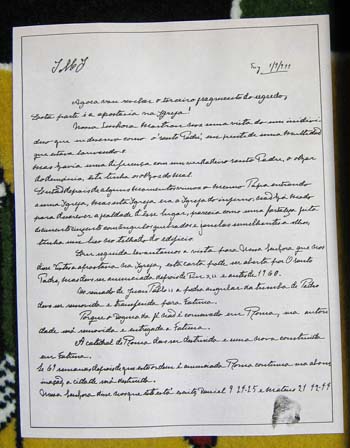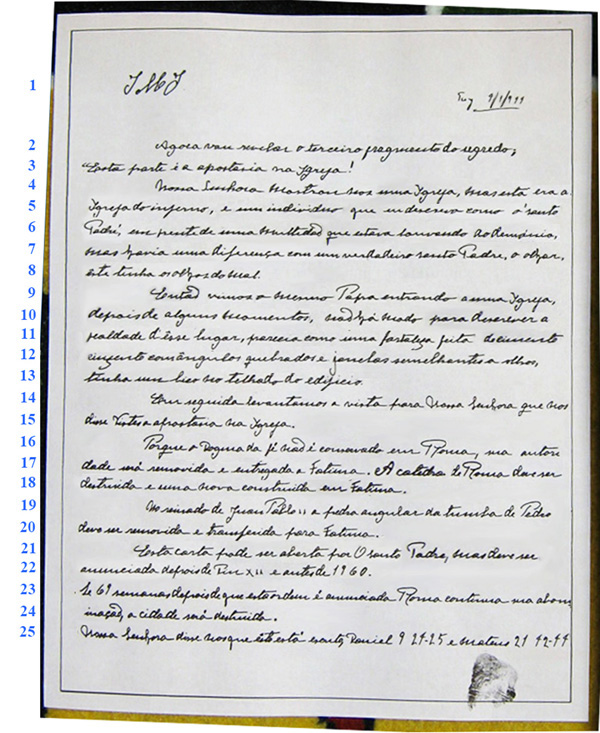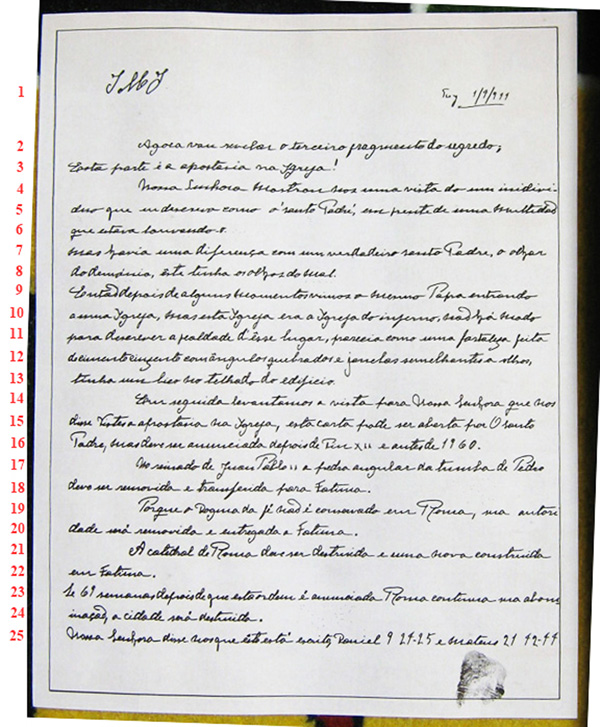Third Secret of Fatima: Trying to Decipher a Scrambled Message
Encouraged by the verdict of a famed Spanish graphologist affirming the authenticity of the Sister Lucy’s handwriting in the “Third Secret’ of Fatima we posted in April 2010 on our website, I have returned to analyze it more carefully.
Note: To follow this analysis in an easier way, print the larger text here
I always had suspicions regarding the date April 1, 1944 (line 1), April Fools’ Day, which most probably should have been January 4, 1944, and by the ill-sounding expression “the Cathedral of Rome” (line 21), which to make sense should be “Cathedra or Chair of Rome” signifying the Holy See. Some days ago I started to scrutinize that “Third Secret” looking for more traces of a possible falsification.
I found some and worked with them. It is the fruit of this labor that I pass on to our readers in this article.
Before starting, let me say that the analysis that follows has four presuppositions:
Note: To follow this analysis in an easier way, print the larger text here
I always had suspicions regarding the date April 1, 1944 (line 1), April Fools’ Day, which most probably should have been January 4, 1944, and by the ill-sounding expression “the Cathedral of Rome” (line 21), which to make sense should be “Cathedra or Chair of Rome” signifying the Holy See. Some days ago I started to scrutinize that “Third Secret” looking for more traces of a possible falsification.
I found some and worked with them. It is the fruit of this labor that I pass on to our readers in this article.
Before starting, let me say that the analysis that follows has four presuppositions:
- If some falsifier entered the picture, he maintained the same number of lines and paragraphs as the original message of Sr. Lucy. He also kept the same words written by Sr. Lucy. Why would he do this? I will try to answer this question during my analysis.
- If a falsification was made, it probably took place at the time of
John XXIII, who was the Pope targeted to receive the message, open it
and make it public. If we take the year of 1960 as a point of reference,
we have a span of about 57 years between the falsification and today.
- If a falsifier is present, he used a non-electronic photographic
system of cutting and pasting pieces of her writings in a different
order from the original. The goal of his alterations would be to
maintain the same handwriting but scramble the meanings of some parts. I
have no idea about the tools or the method he would have employed. I
will just be analyzing the fruit of his work.
- My work will be basically to try to undo what this falsifier would have done. So, I will also cut and paste – through a Photoshop program I use – the parts that I believe were shuffled or adulterated and post them in the places I think they should originally be. At the end of this article I will propose a new presentation of the “Third Secret” TIA posted.
One of the first good impressions I had when reading this message is the discipline of Sr. Lucy's writing. Her handwriting is quite regular, possibly having a lined paper under her letter to orient her. She also made paragraphs with a very marked and consistent indentation, possibly also following that marked paper underneath.

A strange inconsistency: no indentation on the 3rd paragraph
The lack of indentation in the last two paragraphs can be easily explained: She was reaching the end of her letter and probably wanted to keep the message on a single page. So, she dispensed with the indentation and contracted her handwriting. This makes sense.
But why didn’t she use indentation in paragraph three, when she was still at the beginning of her letter? It is difficult to imagine that she would be careless in a letter revealing a secret about the most important episode that happened in her life. Added to this, she was writing, under the command of the Bishop, a message to be delivered to the Pope. It is almost impossible to believe that she would be hasty or careless in the presentation of her letter.
Considering this, I thought: Something looks strange to me in the unindented paragraph three. It could reveal the presence of a falsifier who introduced some texts and, for this reason, was obliged to eliminate the indentation and diminish the space between the words in that paragraph.
With this suspicion in mind, I went on to check another oddity that appears in paragraph two.
Empty spaces & poor grammar
When I analyzed line 6, I saw that there is a large empty space after the word “louvando-o” [praising him]. Now then, the phrase of line 7 that starts with the word “mas” [but] appears to be another paragraph without indentation, but actually it is the continuation of line 6. Why would she leave this long space and continue the thought on a new line without indenting it? It makes no sense.
A useful parallel observation: Throughout this message, Sr. Lucy’s “m” in lower case looks like a capital “M” for starting a word. It is a peculiarity of her handwriting. This can be noticed in line 4, the 3rd word – “mostrou-nos” [she showed us] – and in line 10, the 4th word and the last word – “mas” [but] and “modo” [way]. In line 16, the “m” in the 2nd word –“mas” – looks correct in lower case.
So, whether we consider the first word “mas” in line 7 as written in upper case as coming after a period or in lower case as coming after a coma, it is the logical continuation of the phrase of line 6:

line 4 - (indentation) Our Lady showed us the individual
line 5 - who I describe as the 'holy Father' in front of a multitude
line 6 - that was praising him. [STRANGE LONG EMPTY SPACE]
line 7 - but there was a difference from a true Holy Father
At this point, the hypothesis of a falsifier becomes much more probable.
Another strong suspicion came to my mind looking at the words of line 6: “que estava louvando-o” [that was praising him]. In Portuguese the end of this phrase sounds awkward. Grammatically speaking the correct usage would be “que o estava louvando.”
It is bad grammar in Portuguese to end a phrase with the pronoun “o.” Why would Sr. Lucy do this? She most probably had a good Portuguese, as I can surmise from her other writings. As a Brazilian, I have personally observed that in Portugal even the simple people speak and write a very good Portuguese.
Therefore, this placement of the pronoun “o” seemed suspicious to me. If the hyphen in “louvando-o” [praising him] were removed, the pronoun “o” [him] would change its meaning and become the article “o” [the].
For a falsifier, it would be a very simple matter to insert a small hyphen in “louvando-o.”
So, I deleted the hyphen and the phrase completely changed its meaning. Instead of the translation of lines 5 and 6 being “the ‘holy Father’ in front of a multitude that was praising him,” I found another meaning: “the ‘holy Father’ in front of a multitude that was praising the…” The what?
Something is missing here. It certainly looked as if the falsifier had inserted that little hyphen to hide the indirect object of the original phrase of Sr. Lucy.
I searched for an indirect object that would fit into that incomplete phrase. I found it in line 8: The two words “do demônio” [of the devil] seemed superfluous. I translate lines 7 and 8 to make my point.
line 7 - but there was a difference from a true Holy Father, his gaze
line 8 - of the devil, this one had the eyes of evil.
It became something terrible: “the ‘holy Father’ in front of a multitude that was praising the devil.” In Portuguese there is a nuance in the expression “em frente” that is not fully translated by the English equivalent “in front of.” It can also mean “leading.” So, the translation would be “the holy Father leading a multitude that was praising the devil.”

line 5- Church of hell, and an individual who I describe as the 'Holy
line 6- Father,' leading a multitude that was praising the devil.
If this was, indeed, the original message, it would clearly explain why John XXIII did not reveal this message and would have asked a falsifier to scramble it in a way that would be very difficult to decipher in case it were found.
It also would explain the words of Card. Ottavianni, which I paraphrase: John XXIII ordered the Third Secret to bury the secret in a deep, deep well so that no one could ever find it. Metaphorically speaking, wouldn’t this scrambling of the original text be the “well” he mentioned?
Rebuilding paragraph two
Even after placing “ao demônio” in line 6, I saw that there was still an empty space. What could fill it appropriately? I searched for more superfluous words in the other parts of the message.
In line 10, I found the word “Ygreja” [Church] used three times in a redundant way, entirely unnecessary for the idea to be clear.
line 9 - Then, after some moments we saw the same Pope entering
line 10 - a Church, but this Church was the Church of hell; there is no way
I believe I found the right place in line 4. Let me explain.
Line 4 was another awkward construction. It reads: “Nossa Senhora mostrou-nos uma vista do um inidivíduo.” Translated: "Our Lady showed us a view of the one individual"
There are many mistakes in this construction. To say that someone shows a view of someone is a redundancy. That is why in our first redaction of the letter we translated the line as simply "Our Lady showed us the individual…"
Also there is an error in the use of the articles:
- “do” or “de o” [of the] uses the definite article “o”;
- “de um” [of one] uses an indefinite article;
- To use both at the same time is a serious mistake.
I took out that ill-sounding expression and replaced it with part of the phrase that used the word Church three times.
So, lines 4-5 became: “Nossa Senhora mostrou-nos uma Ygreja, mas esta era a Ygreja do inferno” [Our Lady showed us a Church, but this was the Church of hell],
line 4- Our Lady showed us a Church, but this was the
line 5 - Church of Hell, and an individual who I describe as the 'holy
Thus, the whole paragraph two became more consistent. It now reads: “Our Lady showed us a Church, but this was a Church of hell, and an individual who I describe as the ‘holy Father’ leading a multitude that praised the devil, but there was a difference from a true holy Father, the gaze, this one had the eyes of evil.”

line 4-Our Lady showed us a Church, but this was the Church of hell,
line 5 - and an individual who I describe as the ‘holy
Line 6 - Father’ leading a multitude that praised the devil,
line 7 - but there was a difference from a true holy Father, the gaze,
Line 8 - this one had the eyes of evil
After these changes to paragraph two, the result was that paragraph three read better, becoming much less busy and allowing me to insert the same indentation used in the other paragraphs, giving more harmony and consistency to the presentation of the letter.
These are the essential rearrangements I made. The others did not change the substance of the message; they do, however, present a better order.
Inconsistency of topics in paragraph four
At this point in my analysis, I had come to the conclusion that the entire message had been scrambled. So, I looked for other places were the falsifier had left traces of his action.
Another bad impression came from the change of topics in paragraph four. Lines 14 - 16 of the falsified version reads:

line 14 - Next, we raised our eyes to Our Lady who said to us,
line 15 - You saw the apostasy of the Church, this letter can be opened by the Holy
Line 16 - Father, but it must be announced after Pius XII and before 1960.
So, I kept this important declaration of the apostasy in the Church in one entire paragraph to highlight it and placed paragraphs six and seven, which describe the punishments for the apostasy, closer to it.
After this, I inserted paragraph five, about the cornerstone of Peter’s tomb, which is another consequence of the apostasy. Since in this new paragraph the first letter of the word “esta” [this] was in lower case, I copied the upper case “E” of the first word of paragraph three “Então” [then] and pasted it over the “e” of the “esta.”
Then, I made a new paragraph with those words of Our Lady’s order to open the secret. It seemed to me that they belong there.
I left the two last paragraphs without any change. They seemed well placed to me.
The final deciphered version thus reads, line by line:
Now I am going to reveal the third fragment of the secret;
This part is the apostasy in the Church!
Our Lady showed us a Church, but this was a
Church of hell, and an individual who I describe as the 'holy
Father' leading a multitude that was praising the devil,
but there was a difference from a true holy Father, the gaze,
this one had the gaze of evil.
Then we saw the same Pope entering a Church,
after some moments, but there is no way to describe the
ugliness of that place, it looked like a gray cement fortress
with broken angles and windows similar to eyes;
it had a beak in the roof of the building.
Next, we raised our eyes to Our Lady who
said to us: You saw the apostasy in the Church.
Because the dogma of the faith is not conserved in Rome, its authority
will be removed and delivered to Fatima. The cathedra [or chair] of Rome will be
destroyed and a new one built in Fatima.
In the kingdom of John Paul II the cornerstone of Peter's tomb
will be removed and transferred to Fatima.
This letter can be opened by the holy Father, but it must be
announced after Pius XII and before 1960.
If 69 weeks after this order is announced, Rome continues its
abomination, the city will be destroyed.
Our Lady told us that this is written, [in] Daniel 9:24-25 and Matthew 21:42-44.
(thumbprint)

The corrected text
As I reach the end of my analysis, I see that the falsifier had three principal goals in sight:
- To do away with the accusation that the Pope was praising the devil;
- To avoid presenting the institutional Church as the “Church of hell;”
- To dilute and confuse the chastisements to come: The chair of Peter will be destroyed and will be re-established in Fatima.

No one remains unpunished
after trying to ridicule of Our Lady
Why did the falsifier give the date of April 1 to his scrambled message? Most probably to discredit it as much as possible and make people believe that the whole history of Fatima is just a “story of children,” as Benedict XVI called it.
In order to vindicate Our Lady, her message and Sr. Lucy, I am posting this analysis on the same date of April Fools' Day to make fools of those who want to ridicule Our Lady.
God also knows how to use irony.
Do I imagine that this is the complete deciphering of the message of Fatima and what I presented here is the true Third Secret?
I just exposed what I believe to be wrong. The result is a text that makes much more sense than the document we already had. If this is the real secret that Sr. Lucy wrote, I would be greatly honored to have brought it to light. If it is not, this analysis is meant to foment the debate in order to induce the real document to come to light.


The scrambled text at left [larger here], the deciphered text at right [larger here]
